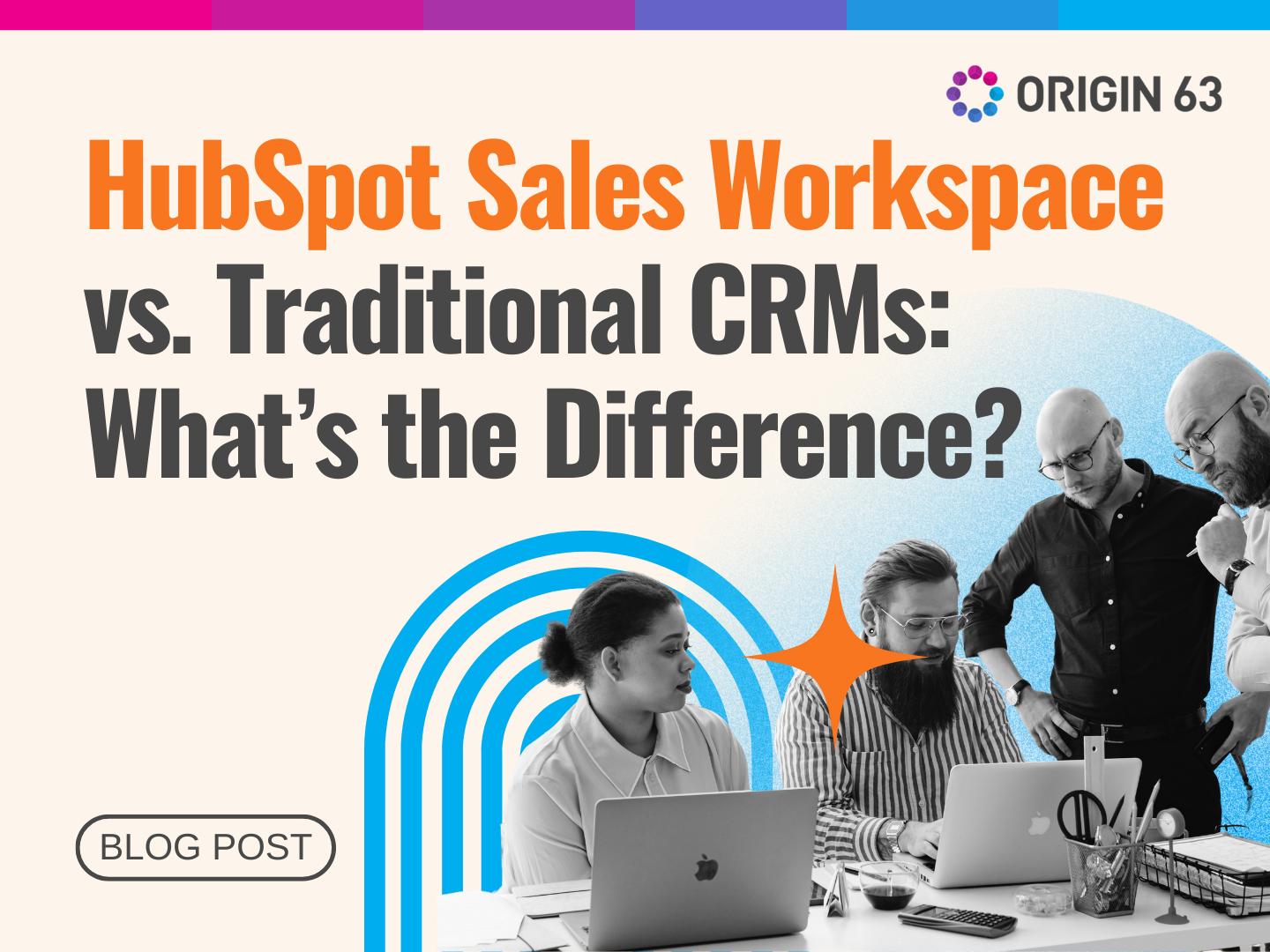Accurate reporting is the backbone of informed business decisions, but spotting trends across so much data can be challenging. Businesses need a way to quickly interpret patterns without getting bogged down by raw numbers.
Enter HubSpot’s trend lines for reports, a new feature to simplify data analysis. Trend lines help you visualize data trajectories, uncover insights, and act on them faster.
Let’s look at how trend lines work, why they matter, and how they can enhance your approach to reporting and analytics.
What Are Trend Lines?

Trend lines are precisely what they sound like—a simple way to spot trends in your data. Adding a trend line to your reports helps you identify common patterns, changes, and overall trajectories in your metrics.
For instance, imagine tracking your monthly lead volume. A trend line can reveal whether your lead generation efforts are consistently improving, plateauing, or declining, helping you adapt your strategies accordingly.
This feature is handy for identifying subtle changes that might otherwise go unnoticed.
For example, a sales manager analyzing deal close rates over the past year could use a trend line to confirm whether their team’s performance aligns with seasonal fluctuations or broader market trends.
How to Add Trend Lines in HubSpot
Adding trend lines to your reports is a straightforward process, but doing it effectively can make a big difference in how you interpret your data. Follow these steps to add trend lines and make the most out of this powerful feature.
Step 1: Open a Report
Start by navigating to a report within your HubSpot portal. You can do this by selecting a report from your dashboards or creating a new one from scratch.
Pro Tip: Choose a report that aligns with the specific trends you’re trying to uncover. For instance, if you’re analyzing monthly revenue, pick a time-series report that shows revenue growth over several months or quarters for maximum impact.
Step 2: Access the View and Filter Options

Once your report is open, look for the View and Filter settings, usually in the report editor or sidebar. This is where you can adjust how your data is displayed and add additional layers of analysis.
Pro Tip: Clean up your report’s filters before adding a trend line to ensure the data set is relevant. For example, exclude test deals or inactive pipelines to avoid skewed results if you're evaluating sales trends.
Step 3: Add the Trend Line
Alt Image Text: Add the trend line, HubSpot Reporting
Under the View options, you’ll see the option to add a trend line. When you select it, HubSpot will offer two types of trend lines:
- Linear Trend Line: Best for datasets with a consistent upward or downward trajectory, such as monthly sales revenue.
- Logarithmic Trend Line: Ideal for datasets with exponential growth or occasional outliers, such as website traffic spikes.
Pro Tip: If you’re unsure which type to choose, try both and compare the fit. A linear trend line works well for steady metrics, but a logarithmic one can better illustrate growth curves or predict performance in rapidly scaling efforts.
Step 4: Customize and Save
Once the trend line is applied, review how it integrates with your report. Ensure it visually aligns with your data and communicates the trend you’re analyzing. If you’re happy with the result, update the existing report or save it as a new one.
Pro Tip: Add annotations to your reports to provide context for stakeholders. For example, if you notice a dip in a trend line during a particular period, note that it coincides with a specific campaign or external event. This makes the report easier to understand and more actionable.
Why Trend Lines Are a Game-Changer for Your Reporting
HubSpot’s trend lines aren’t just another visualization tool—they provide critical insights that can elevate how you analyze and act on your data. Let’s explain why this feature is so impactful:
1. Spot Patterns and Anomalies
Trend lines help you uncover recurring patterns or detect anomalies that might go unnoticed in raw data. For instance, you can pinpoint if sales consistently peak during specific months or identify unexpected dips in performance that warrant a deeper dive.
Businesses that use advanced data analytics, including trend identification, are 23 times more likely to acquire new customers and six times more likely to retain them.
Use trend lines to benchmark your team’s performance. If you spot an anomaly, compare it against external factors like market conditions or internal changes such as shifts in strategy or personnel.
2. Understand Changes Over Time

With trend lines, you can easily visualize how your metrics evolve. This makes identifying growth trajectories or stagnation points easier, empowering you to make data-driven predictions about the future.
Imagine tracking your website traffic over the past year. A logarithmic trend line might reveal that a successful SEO strategy implemented six months ago drives exponential growth or that recent stagnation indicates it’s time to revisit your content strategy.
Combine trend line insights with other HubSpot features, like forecasting tools, to validate predictions and create actionable plans.
3. Save Time with Smart Visualization
Gone are the days of manually crunching numbers to spot trends. HubSpot’s trend lines do the heavy lifting for you, offering a clean and accurate visualization that simplifies complex datasets.
Let’s say your sales team monitors deals closed over time. A linear trend line can confirm whether growth is steady, while a logarithmic one might reveal a recent surge in high-value deals. This saves hours of manual analysis and allows your team to focus on strategy instead.
Studies found that organizations employing AI and big data analytics in their businesses have an adoption rate of 60%.
Automate trend line updates by saving them in your reports. This way, your team always has the latest data without needing to reapply the settings.
Pro Tips for Mastering Advanced Reporting in HubSpot
To make the most of HubSpot’s trend lines, it’s important to go beyond the basics. These strategies will help you build reports that not only look great but also deliver actionable insights.
1. Leverage the Custom Report Builder
The Custom Report Builder is your playground for creating highly tailored reports. Start by selecting only the data sources you need.
For example, if you’re analyzing marketing campaigns, focus on email performance and website analytics rather than pulling in unrelated sales data.
Once you’ve got your data sources locked in, it’s time to add some focus. Narrow things down by including specific fields or applying filters. Say you’re tracking the performance of a campaign across different regions—set a filter for geography to keep your report targeted and meaningful.
Don’t forget about Smart Charts! HubSpot can suggest the best chart type for your data, making it easier to visualize trends or segment insights. Another pro tip: Start simple. Build a basic report first, then layer on complexity as you refine your focus and add more details.
2. Select the Right Chart Type
The right chart can make or break your trend line analysis. Line charts are ideal for tracking changes over time—think monthly sales or website traffic. Area charts, on the other hand, are great for highlighting cumulative growth, like total leads generated during a campaign.
If you’re comparing two datasets, like ad spend versus revenue, combination charts let you plot both on separate Y-axes for a dual perspective. Just be careful not to overcrowd the chart with too much data and avoid data overload. The goal is to make trends clear, not confusing.
3. Use Logarithmic Scales Thoughtfully
Logarithmic scales are lifesavers when your data includes extreme outliers, like a huge traffic spike during a product launch. They compress those large values, making it easier to spot overall trends without letting one big number skew the visual.
That said, not every dataset needs a logarithmic scale. If your numbers are relatively consistent, a linear scale will usually do the job just fine. If you do decide to go logarithmic, make sure your chart labels are clear so anyone viewing the report understands what they’re looking at.
Here’s a rule to help guide you:
When to Use It: If your dataset contains outliers—like a sudden spike in traffic due to a viral campaign—a logarithmic scale can help flatten the extremes, making the overall trend easier to spot.
When to Skip It: If your data points are relatively close in range, a linear scale is sufficient and keeps the visualization simple.
4. Add Goals for Context

A trend line by itself is great, but adding a goal line takes it to the next level. Let’s say your sales team is aiming for 100 deals closed each month. Overlaying that target on your trend line makes it immediately obvious whether you’re hitting your mark or falling short.
Goals also make it easier to track progress over time. For example, if your customer support team is working to reduce response times, a trend line alongside a goal line can show whether your efforts are paying off—or if there’s room for improvement.
When you compare your trend line to your goals month after month, patterns emerge that highlight strengths or areas for improvement.
Making the Most of Trend Lines in HubSpot
Trend lines in HubSpot reports are a practical way to simplify your data and focus on what matters most. They help you reveal patterns, spot problems early, and understand how your performance evolves over time—all without spending hours analyzing raw numbers.
When set up correctly, these visual tools can transform your reports into action plans, helping you make better decisions faster.
However, having access to the tools isn’t enough. To get the most out of HubSpot’s reporting features, you should tailor them to your unique business needs and goals and keep refining.
Trends change, and so do your priorities. Set a schedule to review your reports and update them as your business evolves.
Work Smarter with O63 and HubSpot
O63 specializes in making HubSpot work smarter for your business. We don’t just hand you tools; we help you use them in ways that solve real problems and uncover opportunities.
We’ll work with you to define what success looks like and ensure your reports are built around those objectives. Our team will customize HubSpot’s features, like trend lines, so they’re easy to use and deliver meaningful insights.
We also provide hands-on training to make sure your team knows how to leverage HubSpot effectively, turning data into decisions. If you’re ready to move beyond the basics and start making data-driven decisions with confidence, reach out to O63 today!




.png)
.png)








.png?width=90&height=90&name=Arrows%20Partner%20Badge-test%20(1).png)

